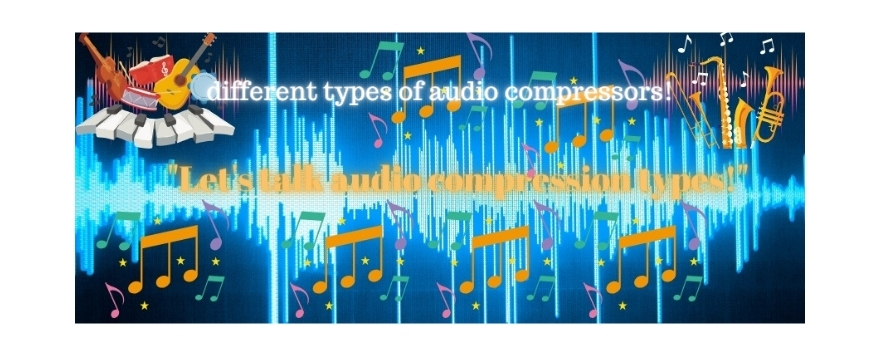A few days ago, we talked about the different types of audio codecs. There are two major types of codecs: uncompressed and compressed. Some people use the term lossless audio instead of uncompressed audio. Examples of uncompressed audio codecs are .WAV and. BWF, while AAC is the commonly used compressed audio format. But why do we need to compress audio data? What are the different types of data compression? And what are the technical terms involved in the process of data compression? I'll try to simplify these concepts for you.
Why do we compress audio?
When we upload audio onto a digital platform and later download it, we typically compress the audio to make it more convenient for listening. However, there is another reason we compress audio - to make it sound more beautiful, pleasant and natural.
A compressor is a tool that reduces the dynamic range of audio and reduces distortion. Compressing audio is both a science and an art, and it's crucial to do it with care since over-compression can spoil the sound. It's beneficial to know the basics before proceeding with compressing audio.
Let's discuss some common terms involved in the compression process.
Threshold: This is the level at which the compression process starts. Audio levels below the threshold won't be affected. Only audio above the threshold will get compressed. For example, if the level is set at -20 dB, then everything below -20 dB won't get compressed, but everything above -20 dB will get compressed.
Knee: Knee refers to how the compressor switches from uncompressed to compressed audio signals. There are two common types of knee - hard knee and soft knee.
Hard knee: A hard knee means that the part of the audio signal which crosses the threshold will get compressed to the full ratio value of the compressor. The hard knee won't activate until the signal crosses the threshold limit.
Soft knee: On the other hand, a soft knee is exactly opposite of a hard knee. It doesn't wait to cross the threshold, and it remains active until the full ratio amount is reached. A soft knee makes the uncompressed to compressed transition smoother compared to a hard knee.
One important term related to knee type is the "ratio". The ratio refers to the amount of attenuation to the audio signal, which determines how much the audio signal can be reduced. For example, a ratio of 2:1 means that if the audio signal exceeds the threshold by 8 dB, the compressor will reduce it by 4 dB Some commonly used compression ratios include 1:1, 2:1, 3:1, 4:1, etc. But what do these ratios actually mean?
A ratio of 1:1 means that the input and output signals are equal, with no compression applied. A ratio of 3:1 means moderate compression is applied, while a ratio of 4:1 means medium compression is applied. On the other hand, a ratio of 8:1 means that stronger compression begins.
Hardware Vs Software compressor
We compress audio to reduce the dynamic range, which is the difference between the loudest and softest parts of the recording. Compressors are used for this purpose, and there are two types: hardware and software (also known as plugins).
Hardware compressors are physical devices, while software compressors are used within digital audio workstations (DAWs). Both have their advantages and disadvantages.
Hardware compressors produce high-quality work, but they can be expensive compared to software or plugins. Passionate sound engineers often prefer hardware compressors because they provide a unique feel, but this doesn't mean that software compressors don't add any value.
They are more affordable and require less effort to set up since they are in digital form. However, you won't experience the same tactile sensation as with a hardware compressor. Additionally, you may get a good resale value with a hardware compressor, but this is not always possible with a software compressor.
There are four main types of hardware audio compressors: Tube compressor, Optical compressor, FET compressor, and VCA compressor. In addition to these four, some other hardware compressors are PWM and Digital compressor.
The Tube compressor is one of the oldest types of compressors and has been in use since 1960. It was invented by Rein Narma. The name tube compressor comes from the use of vacuum tubes for compression.
In an Optical compressor, light plays a crucial role in attenuating the audio signal. The audio signal sends light on which the resistor reacts. It shines with the intensity of light sent by the audio signal.
The more the light, the more it shines, and vice versa. Then the resistor conveys to the compression circuit about how quickly or slowly it should attenuate the audio signals. With optical compression, smoother compression is possible.
Other types, like FET field-effect transistor compressor and VCA (Voltage-controlled amplifier) compressor, have their pros and cons. There is much to talk about every type, and we will see it later.
Software compressor: If you are looking for an easy way to compress audio, using software compressors is the simplest approach. These compressors are user-friendly and don't require complex setups like hardware compressors do.
Some commonly used software compressors are FabFilter Pro-C 2, GRIP Valve Drive Compressor, JST Gain Reduction 2, and Virtual Buss Compressor. Comparing each parameter one by one will help you decide which type of compressor to use for a specific purpose.
For a more natural sound, hardware compressors are better than plugins because software compression is in digital form and can sound artificial. If budget is a concern, software compressors are a good option. Although plugins are becoming more advanced, hardware compressors still have an edge in terms of audio quality.
